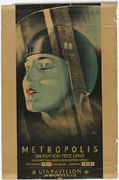Beginning of the Maji Maji Uprising in German East Africa (today Tanzania, Rwanda, Burundi): various African tribes rebel against the oppression and exploitation on German colonial plantations

German Emperor Wilhelm II. (1859–1941). 1905 Picture postcard by Reichard und Lindner, Berlin
Schmidt-Rottluff lives in Dangast and Dangastermoor at the North Sea, near Oldenburg; Heckel joins him in the fall
Kandinsky excecutes the first woodcuts for the "musical album" Klänge (Sounds)
Commissioned by the Wiener Werkstätte, Oskar Kokoschka begins to work on the text and drawings for his "children's" book Die träumenden Knaben (The dreaming boys)
Pablo Picasso completes Les Desmoiselles d'Avignon
Alexei Jawlensky, Gabriele Münter, and Marianne Werefkin live and paint together in the Alpine village of Murnau
Kandinsky works on his first stage composition combining sound, color, and movement
Henri Matisse publishes "Notes of a Painter," arguing for the primacy of "expression" in painting
Gustav Klimt and his followers organize the Kunstschau (Art show) in Vienna, a large-scale independent survey of contemporary Austrian art, theater, and decorative arts; Kokoschka debuts his work there
Germany supports annexation of Bosnia and Herzegovina by Austria-Hungary against the protests of Britain, Serbia, and Russia
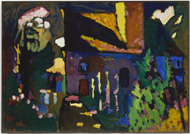
Vasily Kandinsky. Church at Murnau (Kirche in Murnau). 1909. Oil on board. Purchase, 1950
Kandinsky paints first Improvisations
Heckel, Kirchner, and Pechstein work closely together at the Moritzburg ponds near Dresden, painting the nude in motion in a natural environment
Premiere of Kokoschka's one-act play Murderer, Hope of Women at the Gartentheater of the Internationale Kunstschau (International art show)
First Futurist manifesto by F. T. Marinetti published on the front page of Le Figaro
Pablo Picasso and Georges Braque develop Analytical Cubism
In response to the Bosnian annexation crisis, the German chancellor expresses allegiance of the German empire to Austria-Hungary ("Nibelung loyalty")

Oskar Kokoschka. Pietà (poster for Murderer Hope of Women). 1909. Lithograph. Purchase, 1966
Herwarth Walden launches periodical (and publishing house) Der Sturm in Berlin; he will open Galerie Der Sturm in 1912
Kokoschka meets Herwarth Walden in Vienna, later travels to Berlin and contributes to Der Sturm
Nolde works on Hamburg harbor series of prints and drawings
During the summer, Heckel, Kirchner and Mueller work together at the Moritzburg ponds near Dresden
Kandinsky paints first Composition
Increasing interest of Brücke artists in tribal objects and non-Western art
With a population of more than two million, Berlin now the third largest city in Europe, after Paris and London
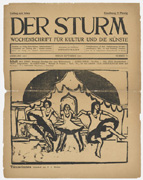
Ernst Ludwig Kirchner. Dancers (Tänzerinnen) from the periodical Der Sturm, vol. 2, no. 77 (September 1911). Woodcut. The Museum of Modern Art Library
After attending a concert by Arnold Schoenberg (also an amateur painter) Kandinsky paints Impression III, one from a group of increasingly abstract works; beginning of exchange between Kandinsky and Schoenberg
Kandinsky and Franz Marc begin to work on the almanac Der Blaue Reiter (The Blue Rider)
Heckel, Kirchner, and Schmidt-Rottluff move to Berlin
Franz Pfemfert issues the first number of the periodical Die Aktion
Kandinsky publishes his theoretical treatise Über das Geistige in der Kunst (Concerning the Spiritual in Art) [date of publication on book: 1912]
Founding of the Pathetiker group by Ludwig Meidner, Jacob Steinhardt, Richard Janthur; emphasis on "pathos" as primary trajectory of expression
Paul Klee visits Robert Delaunay in Paris, working on his abstract series Windows, composed of flat blocks of color; Marc and August Macke meet Delaunay in fall
Balkan Wars of 1912 and 1913 contribute to tensions among Russia, Austria-Hungary, Great Britain, France, and Germany; German military increasingly convinced that war seems inevitable

Erna Schilling and Ernst Ludwig Kirchner in Kirchner's studio at Durlacher Straße 14 in Berlin. c. 1912/14. Photographed by Ernst Ludwig Kirchner. Kirchner Museum Davos, Switzerland. Gift of the Ernst Ludwig Kirchner Estate
Marc plans to issue a Blaue Reiter–illustrated Bible edition; the project comes to an end when he is drafted in August 1914
Brücke announces its dissolution
Emil and Ada Nolde accompany the Department for Colonial Affairs' German New Guinea expedition to the South Seas
Kirchner begins his Berlin Street Scene series of paintings
Berlin: Erster deutscher Herbstsalon (First German autumn salon). Galerie Der Sturm. September 20–December 1. Organized by Herwarth Walden. Influential international survey of avant-garde movements including Futurism, Orphism, Cubism, and Expressionism; Macke and Marc assist in hanging the works
Klee and Macke travel to Tunis, where they each create major series of luminous, semiabstract watercolors
Pechstein begins his travels to the South Seas, reaching the Palau Islands in June; he is forced to leave prematurely when the war breaks out and Japan occupies the archipelago
Kandinsky moves back to Moscow via Odessa
Perthes-lès-Hurlus, France: Death of August Macke in combat (September 26)
The following artists, among others, are drafted or volunteer for military duty in 1914 (or after): Beckmann, Campendonk, Felixmüller, Grosz, Heckel, Kirchner, Klee, Kokoschka, Kolbe, Lehmbruck, Macke, Marc, Meidner, Mueller, Max Oppenheimer (MOPP), Pechstein, Schiele, and Schmidt-Rottluff
Assassination of Archduke Franz Ferdinand, heir to the Austrian throne, in Sarajevo, Bosnia
Outbreak of World War I
Euphoric patriotism among German population; all parties (including the Social Democrats) in the Reichstag approve war bonds to finance "defensive war"

Max Beckmann. Declaration of War (Die Kriegserklärung). 1914. Drypoint. Abby Aldrich Rockefeller Fund, 1951
Beckmann has a mental breakdown and is dismissed from service as medical orderly. Between 1914 and 1918, he creates more than 150 works relating to his experience of the war
Grosz is dismissed as unfit for military service
Heckel is stationed as a medical orderly in different cities in Flanders
Kirchner begins military training in field artillery, but is declared unfit for service
Dix joins the trench war on the Western Front in France, serving as a machine-gunner and troop leader
On the Western Front, in fall 1914, and on the Eastern Front, in winter 1915–16, the battle stagnates into an agonizing trench war
In the Second Battle of Ypres, Flanders, the German army uses chlorine gas for the first time, killing 3,000 Allied soldiers
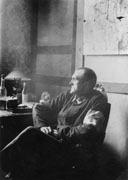
Max Beckmann as medical orderly in Ypern. 1915. Max Beckmann Archive, Munich
Death of Marc, near Verdun
Having served on the Eastern Front, Kokoschka is severely injured, and later dismissed due to shell shock
Georg Gross changes his name to George Grosz, symbolically resisting nationalist war propaganda
Schmidt-Rottluff, stationed in Kowno, finds himself unable to paint, and works predominantly in woodcut and wood sculpture
Cabaret Voltaire, cradle of the Zurich Dada movement, opens
German artillery offensive in Verdun; heavy casualties on both sides
Falling agricultural production causes extreme food shortages; the mass deaths at the front, the hunger crisis, and rising inflation at home lead to an increasing war weariness among the German population
Kirchner, having spent time in sanatoriums for treatment of his nervous condition and substance abuse, travels to Davos, in the Swiss Alps
Pechstein is released from military duty and returns to Berlin
The Dresden artist Felixmüller and others begin to organize Expressionist soirées at Felixmüller's studio, evolving into the Expressionist Working Group Dresden; the group promoted pacifism, socialist ideas, and politically engaged art
Beckmann creates several religious paintings inspired by Gothic and Northern Renaissance panel painting, which he absorbed while stationed in Belgium
Mass uprisings in St. Petersburg and other Russian cities in call for the abdication of Czar Nicholas II; collapse of the czarist regime; in November the Bolshevik Party takes power
Germany agrees to peace negotiations with Russia, and armistice is signed in Brest-Litovsk
Responding to the intense submarine offensives, the United States declares war on Germany

Max Beckmann. Descent from the Cross (Kreuzabnahme). 1917. Oil on canvas. Curt Valentin Bequest, 1955
Artists and intellectuals, politicized as a result of the war and the prospect of radical social change, form the Workers' Council for the Arts (1918–21) in Berlin; among the artists are former Brücke members Heckel, Mueller, Nolde, Pechstein, and Schmidt-Rottluff
First meeting of the November Group (1919–32) in Berlin: founding members include Pechstein and César Klein, among others. The aim is to unite artists across disciplines and to make art a tool of social and political transformation, and to organize annual exhibitions
The Council of People's Representatives' propaganda organ, the Publicity Office, enlists artists of the November Group in a political poster and pamphlet campaign in support of the provisional revolutionary government and national assembly elections
The pacifist-socialist group Spartacus League calls for mass strikes; demonstrations break out in major German cities demanding "peace for bread"
On October 29, sailors mutiny in the cities of Kiel and Wilhelmshaven, Germany; strikes and uprisings spread throughout other German cities, and soldiers' and workers' councils take over local city governments, inaugurating the November Revolution
On November 9, the German chancellor announces the abdication of the Kaiser; Social Democrat Philipp Scheidemann proclaims a parliamentary republic from a window of the Reichstag in Berlin
Germany signs the armistice at Compiègne, France. At the war's end, total casualties stand at almost 9 million dead and 21 million wounded
Founding of the German Communist Party
The Dresden Secession Group 1919, a revolutionary Expressionist artists' group, is founded under the leadership of Felixmüller; Dix is among the members
Käthe Kollwitz creates preparatory sketches and prints for the woodcut In Memoriam Karl Liebknecht (1920), a tribute to the murder of the Communist leader
Suicide of Wilhelm Lehmbruck
Staatliches Bauhaus opens in Weimar, under the directorship of Walter Gropius
Grosz, Felixmüller, John Heartfield, and Wieland Herzfelde join the Communist Party
Spartacus uprising in Berlin: Members of the Communist Party and the Independent Social Democratic Party call for armed resistance against national assembly elections and in support of a German Soviet republic
Murder of the Communist leaders Rosa Luxemburg and Karl Liebknecht; many Germans are shocked by the brutality of the murders
While political unrest continues in the streets of Berlin, the constitutional assembly convenes in the small city of Weimar
Signing of the Treaty of Versailles. Germany, blamed for the war, will be held to considerable reparations
President Friedrich Ebert signs the Weimar Constitution into law

Spartacists fighting in the newspaper district [Zeitungsviertel] of Berlin using newspapers as a barricade. January 1919
Berlin premiere of the film The Cabinet of Dr. Caligari (Das Kabinett des Dr. Caligari), directed by Robert Wiene
Opening of the International Dada Fair, Berlin, including Grosz's print portfolio God with Us, a political satire on the German military; he is brought up on trial for libel against the German army
Political instability, economic crises, social problems, and collective traumatization from the war challenge the early republic, and are exploited by right-wing extremists
First mass meeting of the anti-Semitic nationalist German Workers' Party in Munich. Adolf Hitler announces the party program as well as the party's renaming to the National Socialist German Workers' Party
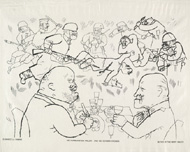
George Grosz. Écrasez la famine / Blood is the Best Sauce / Die Kommunisten fallen und die Devisen steigen from the portfolio God with Us (Gott mit uns). 1919, published 1920. Photolithograph. Abby Aldrich Rockefeller Fund, 1949
In the aftermath of the war, destabilization of the national budget continues due to rising inflation, new national debts, and the social costs caused by returning war victims
The Allied Reparations Committee sets German war reparations at 132 billion gold marks (payable over 42 years) and poses a six-day ultimatum
Premiere of the film Nosferatu, directed by F. W. Murnau
Kandinsky joins the Bauhaus, Weimar
Grosz embarks on a five-month trip to Soviet Russia; increasingly disillusioned, he decides to quit the Communist Party in 1923
Continuing drastic currency devaluation and spiraling national debt; as a result, Germans increasingly invest in material assets, including art
Rapallo Treaty between Germany and Soviet Russia: both sides agree to cancel each other's reparations and resume diplomatic relations
The NSDAP, with approximately 20,000 members, holds its first party rally in Munich
Hyperinflation reaches its peak (one dollar equals four billion marks); millions of people lose their savings. In November reform is enacted to curb the spiraling currency devaluation
In Munich, Hitler unsuccessfully initiates a putsch, and will be sentenced to five years in prison for treason

Selling money by weight at the height of hyper-inflation. Paper money is worth more by weight than old bones, but less than rags. November 1923
Second censorship trial against Grosz and his publishers for the portfolio/illustrated book Ecce Homo (1922), which featured 100 offset lithographs after satirical drawings by Grosz
Dix's monumental painting Trench (1923) is exhibited at the Berlin Academy and draws vehement criticism for its perceived antiwar imagery
First issue of the periodical La Révolution surréaliste (The Surrealist revolution)
Hitler is prematurely released from prison, where he finished the first volume of Mein Kampf (My struggle)
With the currency reform of 1923 and the Dawes Plan, a major step toward recovery, beginning of relative economic and political stabilization
The Bauhaus moves from Weimar to Dessau
Dix moves to Berlin; close contact with Grosz
Neue Sachlichkeit. Deutsche Malerei seit dem Expressionismus (New Objectivity. German painting since Expressionism). Kunsthalle Mannheim. June 14 –September 13. Includes Beckmann, Dix, Grosz, Alexander Kanoldt, Rudolf Schlichter, and Georg Scholz, among more than 30 artists
Hitler reconstructs the NSDAP in Munich, adopting new "legal" tactics to undermine the republic through broadening the party base
The monarchist and former general field marshal Paul von Hindenburg is elected president
Berlin premiere of The Battleship Potemkin (after ban imposed in March had been lifted)
Berlin premiere of the film Faust, directed by F. W. Murnau
Vasily Kandinsky. Punkt, Linie zur Fläche. Beitrag zur Analyse der malerischen Elemente (Point and line to plane. Contribution to the analysis of the pictorial elements)
Frequently changing cabinets, many of which are formed without a parliamentary majority, characterize the fragile political system of the Weimar Republic; three cabinets are formed and dissolved between 1926 and 1927
Premiere of the film Metropolis, directed by Fritz Lang
Premiere of Walter Ruttmann's experimental film Berlin: A Symphony of a Great City
Kollwitz attends the World Congress of Friends of the Soviet Union in Moscow, held on the occasion of the 10th anniversary of the Russian Revolution
Anti-Semite Alfred Rosenberg establishes the National Socialist Society for German Culture in Munich, later known as Combat League for German Culture, a cultural nationalist propaganda organ against modern art and precursor to the "degenerate art" campaign
Berlin premiere of the play Die Abenteuer des guten Soldaten Schwejk (The Adventures of the Good Soldier Schweik) directed by Erwin Piscator in collaboration with Bertolt Brecht, and with theatrical designs by Grosz. A portfolio of reproductions after drawings for the play leads to charges against Grosz for blasphemy
The New York Stock Exchange crashes, triggering worldwide economic crisis. Short-term loans (primarily from the United States), which had enabled German economic recovery, are largely withdrawn
Unemployment in Germany spirals to approximately six million by the end of 1932; the crisis overpowers the social-security system, and famine and poverty surge
Death of Otto Mueller
Wilhelm Frick, Minister of the Interior and Education of the state government of Thuringia, orders the removal of approximately 70 modern paintings from the Schlossmuseum, Weimar
National Socialists protest the Berlin premiere of Lewis Milestone's All Quiet on the Western Front (based on the novel by Remarque)
Early elections take place on September 14, resulting in a major breakthrough for the Nazi Party
German unemployment rises to more than 4.5 million
In Frankfurt, Beckmann begins work on his triptych Departure
The city legislature of Dessau, with a right-wing state government in place since May, terminates classes at the Bauhaus; Mies van der Rohe moves the school to Berlin
Last issues of the periodicals Der Sturm and Die Aktion
Hindenburg is reelected president
Early elections are held. The Nazi party more than doubles its votes since the last election; Kollwitz, author Heinrich Mann, and others sign a public appeal to promote the cooperation between the Communist Party and the Social Democratic Party against the rise of fascism
Mass unemployment reaches its peak
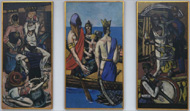
Max Beckmann. Departure (Abfahrt). Oil on canvas, three panels. Given anonymously (by exchange), 1942
Kollwitz and Mann are forced to quit the Prussian Academy
Establishment of the Reich Culture Chamber under Joseph Goebbels leads to centralized state supervision of culture and purging of "non-Aryans" and nonconformists from art and cultural institutions. Exclusion from membership in the Reich Chamber of Art resulted in an occupational ban, forcing many artists to emigrate or work in private
"Defamatory exhibitions" are held in various German cities; these mark the beginning of the "degenerate art" campaign, which culminates in the 1937 Degenerate Art exhibition in Munich
Hindenburg appoints Hitler as chancellor
Burning of the Reichstag, Berlin; emergency decree enables large-scale persecution of political dissidents
Reichstag elections are held. The NSDAP wins 43.9 percent
Ministry of Public Enlightenment and Propaganda is established under Josef Goebbels
Enabling Act abolishes legislative control by parliament and the president
The first concentration camps are built
Call for boycott of Jewish stores, doctors, and lawyers
Burning of "un-German" books in Berlin and elsewhere
Hitler becomes president and commander-in-chief of the army after Hindenburg dies; confirmed in a referendum by 89 percent of voters

Käthe Kollwitz. Death Grabbing at a Group of Children (Tod greift in eine Kinderschar) from the series Death (Tod). (1934). Lithograph. Purchase, 1940
1937
In 1937 the Nazi regime's campaign against modern art takes a new radical turn, as it prepares for its exhibition Degenerate Art by confiscating works of art declared "degenerate" from German state collections. The exhibition, which includes approximately 730 works by 112 artists, opens on July 19 at the Hofgarten in Munich. Afterward the campaign continues, with the Nazis seizing altogether some 5,000 paintings and 12,000 works on paper (some scholars estimate a total closer to 20,000) from more than 100 museums through 1938. The confiscated works are either destroyed or sold in exchange for foreign currency.

The exhibition Degenerate Art at the Haus der Kunst, Berlin (February 26–May 8, 1938)














